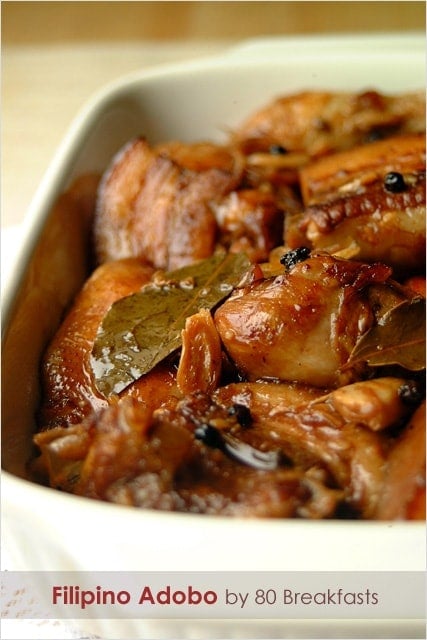This post may contain affiliate links. Please read my privacy policy.
Adobo - a Filipino stew or simmer of meat and vegetables cooked with vinegar. This delicious and easy recipe uses both chicken and pork.

What Is Adobo
Filipino adobo is a delicious stew or a simmer of meat and vegetables cooked with vinegar. It’s an iconic dish in the Philippines, just like lumpia.
The most common versions use chicken or pork or even both, with soy sauce to flavour. Additionally, bay leaf, black pepper, and garlic are used as the pillars of adobo.
That being said, we also have versions using squid (adobong pusit), long beans (adobong sitaw), and water spinach (adobong kang kong). I have seen people use everything from baby back ribs to catfish in adobo.
I don’t think there is, or will ever be, a truly definitive recipe for Filipino adobo.
Ingredients For Adobo
- White cane vinegar
- Toyo
- Chicken (legs, drumsticks, thighs)
- Pork belly
- Black peppercorns
- Laurel leaves
See the recipe card for full information on ingredients.
I like my adobo dark, which is why I use soy sauce. Additionally, I like to mix pork and chicken, despite arguments to the contrary.
I may make adobo using only pork, but I will hardly ever make it using only chicken. The pork makes the whole dish, especially the sauce, more robust so I consider having to fish out of the chicken mid-way a step well worth it.
Cooking Tips
- Use pork belly that still has the bones attached and skin on – then make your butcher cut it into nice chunks (I like biggish pork chunks in my adobo).
- The bones and skin will work wonders towards giving your sauce more body. Frying the chicken and pork after they’ve been cooked is a messy affair, but it really does make a difference. The caramelized bits of fatty pork and chicken skin will make cleaning an oil spattered kitchen seem like a small price to pay.
- One of the oldest adobo adages is not to stir the sauce until the vinegar burns off most of its “acid”. Another bit of advice I’ve heard is to always leave the garlic skin on.
Optional Tips
- Pop one star anise into the pot to give it a brilliant fragrance and a Chinese flavor.
- If you would like, add a peeled hardboiled egg towards the end of cooking.
- Add one peeled sweet potato to add a touch of sweetness.
- Experiment with different types of vinegars! I also make a version that uses red wine vinegar – and instead of chicken and pork I use lamb shanks and I add in some peeled pear quarters.
- Add a handful of peeled pearl/spring onions to the mix – they will get all melty as the adobo cooks and enrich the sauce.
- Slow cook your adobo in the oven while you do chores around the house.
- Use leftover adobo (flake the meat) for awesome fried rice!
What To Serve With Adobo
This dish is best served as the main entree. For a wholesome Filipino meal and easy weeknight dinner, I recommend the following recipes.
I hope you enjoy this post as much as I do. If you try my recipe, please leave a comment and consider giving it a 5-star rating. For more easy and delicious recipes, explore my Recipe Index, and stay updated by subscribing to my newsletter and following me on Facebook, Pinterest, and Instagram for new updates.


Adobo
Ingredients
- 1/2 cup white cane vinegar
- 1/4 cup toyo, our local soy sauce
- 3/4 – 1 cup water, you may not use all of it
- 3 chicken legs, drumstick and 3 chicken thighs (I like to use dark meat – this should come to about 600-650 g of chicken)
- 350-400 g pork belly, the part with the bone, skin on, cut into generous chunks (about 2 inches)
- 1 1/2 teaspoons whole black peppercorns
- 8-10 cloves garlic, just slightly bashed, skin still on (do not peel!)
- 2 bay leaves
- freshly cracked black pepper, a few twists
Instructions
- Place all the ingredients except for the water in a Dutch oven or any heavy-duty pot and let them marinate for about 30 minutes.
- Place the pot over medium heat, add 1/2 cup of water, and bring it to a boil. Lower the heat to a simmer and cook without stirring until most of the vinegar's acidity has cooked off. You'll know it's done when the smell is no longer sharp or "stingy."
- Continue simmering over low heat until the chicken is very tender, about 40 minutes to an hour. Taste the sauce; if it's too salty or sharp for your liking, add some of the remaining water. I usually use a total of 3/4 cup.
- When the chicken is tender, remove the pieces from the pot and set them aside. The garlic will also be very tender at this point; you can mash some (but not all) of the cloves against the sides of the pot to incorporate them into the sauce.
- Continue simmering on low heat for an additional 30 minutes to 1 hour, or until the pork is meltingly tender. Once the pork is very tender, remove it from the pot and set it aside. Keep simmering the sauce until it reduces to your desired consistency. Taste the sauce; if you'd like a bit of sweetness, stir in a pinch of brown sugar. I like to do this, but it’s not necessary.
- Heat a skillet with some oil over high heat. Once the oil is hot, add the chicken and pork pieces and fry them until browned.
- When the sauce has reduced to your desired consistency, add the browned chicken and pork back to the pot. Toss gently and remove from heat. You can eat it at this point, but the dish gains depth of flavor if you let it rest for a day.
Notes
Nutrition
Nutrition information is automatically calculated, so should only be used as an approximation.










Very nice recipe for adobo.
It has a good cooking technique .
Hi Nell, thanks for trying my recipe! :)
I have not made your version of pancit, lumpia or adobo chicken but make it from memory as taught to y filipino friends. My question is if you have recipe for a coconut milk pudding that I long for. Many years ago (1970s) filipino nurses I worked with got me hooked on Philippine food. I have never been able to find recipe for the pudding. Can you help?
Coconut pudding could be maja blanca
Glad to see the coconut milk mentioned. I made the America’s Test Kitchen version and it’s amazing but friends tell me it’s not REAL adobo because of the coconut. Their loss since it’s SO TASTY!
Hi Bob,
Yes, we do have variation adding coconut milk and it’s common in the eastern part of Luzon (Bicol) spiced with chilies, in addition to soy sauce and vinegar. It’s awesome!
My Filipino maid used to cook Chicken Adobo, one day I taught her to cook stew. I told her that Chinese cuisine’s secret was to fry all the ingredients well before adding in water. The next time when she cooked the Chicken Adobo, it was so, so yummy even herself was shocked. I asked her why this time it tasted so good. She told me that she applied my teaching into her cooking. Since then she cooked well.
So try to cook it the Chinese way, stir fry until dry and then add in the water to simmer.
It’s the best technique. Ilocano adobo (Northern Luzon from where I came from) does the same technique, frying the pork before adding the water, and simmer it until dry.